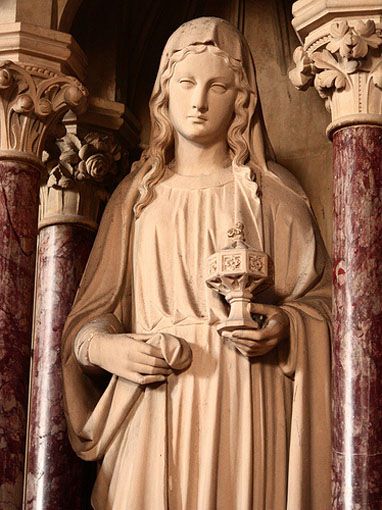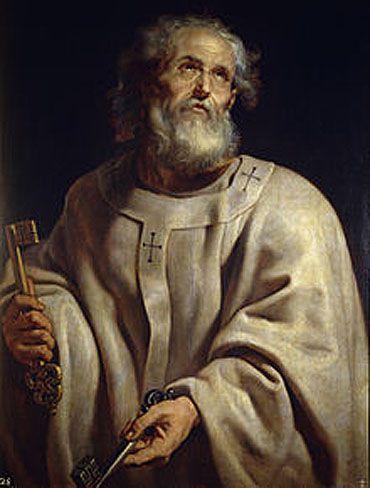MARY MAGDALENE - Emancipated?
A Woman's Life in the time of Jesus
Some people see Mary Magdalene as a feminist icon, and some tell us that Mary Magdalene as a goddess is going to come into her own now, and change the world so that women lead, men follow, and the sacred feminine is all. They talk about centuries of patriarchal repression.
But it seems to me that politically and socially, especially in countries that are nominally Christian, women have more rights now than they have ever had before in history, even if some countries are still lagging behind.
I have a dream in which Mary Magdalene congratulates us all. If she was alive today I should think she would be very happy to live in our society with its wealth of human rights.
 Mary Magdalene in a mild mood
Mary Magdalene in a mild mood
When I look at the status of women in the time that Mary lived, they were treated, legally and politically, as little more than farm animals. That Mary Magdalene succeeded as well as she did in making her voice heard is in itself a miracle. The first time we meet her in Luke, she is called a “sinner”, chapter 7, verse 36; by chapter 8, verse 2, she was one of the women that Jesus had cured and was travelling with him and presumably preaching. Reading between the lines, she is unusual, a little disreputable, perhaps a natural rebel against society?
She lived in the days when female children were owned by their father and were then given in marriage to the husband the father chose for her. Legally, the father’s ownership was transferred to another man during the marriage ceremony. Once a woman was married, she was not only expected to obey her husband, but this obedience was required from her as part of her religious obligation.
Her husband remained, as an individual, completely free, although he was expected to support his women and children, rather as he was expected to feed any animals he owned. He could take as many lovers or wives as he wished and could invite them into the household, as long as he supported them. He could demand a divorce before the rabbis for what we would consider reasonable grounds, such as adultery, but records include demands for divorce on the basis that the wife burnt the dinner or gossiped too much with the neighbours. He had to serve divorce papers - this was considered humane! - before he cast her out of the house with nowhere to go. The papers made it legal (as papers often do.)
What is bizarre to us was that after he had divorced his wife, she could only marry again if he gave his consent! Equally, if a woman was raped, she was then given to the rapist in marriage.
Against this background we can see Jesus’s words against divorce (in Mark, 10, 1 - 9) in a new light. He was speaking to men, not people including women, because only men could initiate divorce. He was trying to persuade men to be kinder to their wives, for so many women were badly treated, thrown out of their homes, and physically beaten, at the husband’s whim. Jesus quoted Genesis, in that God had created marriage, not men, and God had created men and women equal and in his own image.
Women could not be witnesses in a court of law - their words were so unworthy. A daily prayer in the Jewish prayer book thanked God, King of the Universe “for not having made me a Gentile … slave … or woman.”
Life was hard for women in other practical ways. In this ancient world, life expectancy was only 25 years, this low average being caused by infant mortality and childhood diseases; we can see why Jesus was in such demand to heal children. He and other healers were the only resource that many women had to help their children. Statistics tell us that, simply to maintain a stable population at that time, each woman needed to have five successful pregnancies on average. Many women had more, bearing a child every two years throughout her child-bearing life with no anaesthetic, for it was believed she suffered the pain as a result of her original sin.
Thus, the Virgin Mary did well; she bore Jesus, then four brothers and two sisters, that is seven successful pregnancies. I believe she would have had more if Joseph had not died. How many women there must have been, rich and poor, who cried because they could refuse their husband nothing, even though their health could hardly bear another pregnancy and many of the children died before they were a year old?
In those days the definition of adultery was sex outside marriage or sex with someone not the husband within it. Women could be stoned to death for either. This method of execution was considered humane, for the guilty one soon died, at the foot of a cliff, from the top of which boulders were rolled.
This could have happened to the “Virgin” Mary if she had had no-one to protect her. There is no doubt that she was discovered to be pregnant by her fiancé Joseph, and it was not he who was the father. She could have been legally acccused of adultery and stoned. It could be that Joseph “put her away privily” to save her life.
However, if she had been pregnant by him, it was not considered such a sin to have sex with someone you were going to marry anyway, and any resulting child would not be treated as illegitimate. Here, the situation gets complicated if you believe the Virgin Mary was “raped” by a Roman soldier: a Jewish man would have been forced to marry her because it did not matter that he had other wives living, they all had to live together. In Roman law, one could only be married to one person at a time, and in Jewish eyes, to have sex with someone you knew you could not marry was adultery or "fornication."
Women had to always cover their hair and wear a veil in public. They were forbidden to speak to strangers. Women were expected to remain in groups of two or three to evade being accused of “harlotry.” They were to wear “modest” clothes and if they wanted male approval, they could do “good works.” In the synagogues, Jewish women were segregated from the men and had to pray with a veil over their heads; if not, they could be punished by having their heads shaved.
Things relented a little in the early Christian Church, maybe because they needed all the converts they could find; women were allowed to study (education was generally forbidden to Jewish women) as long as they did it "quietly." But taking part in discussions, preaching? Never! Paul said; I permit not a woman to teach, nor to have dominion over a man, but to be in quietness, for Adam was formed first, then Eve.
We know from the stories in the Bible that the anti-women laws were not always adhered to and I expect men and women had relationships as they do today, but the risks were very great and that was the social atmosphere in which women lived.
Jesus was incredible in the way he supported women quite against the spirit of the times in which he lived. Maybe he was more “aware” because he was illegitimate himself. In the early days of his ministry, women were already travelling with him, and preaching, and baptising. They played an important role during his crucifixion, death and resurrection, they were his faithful followers, while the male disciples were in hiding.
In itself, it is amazing that the Gospel writers recorded this, because with the prejudice against them, women were often never mentioned, or were treated as though they didn’t exist.
We hear much more in the Gnostic Gospels, especially about the behaviour of St. Peter. He was so aggressive to Mary Magdalene that she was afraid of him and he told Jesus he did not wish her to live. Jesus, and the other disciples too, came to her defence, in the Gospel of Mary.
 St Peter, the uneducated fisherman who became the first "Pope."
St Peter, the uneducated fisherman who became the first "Pope."
Sometimes what she had to say was far in advance of the others, which leads me to believe that Mary Magdalene, somehow, somewhere, was an educated woman.
Women were accepted as priests later, possibly due to Mary's influence. A film about this gospel discusses the women priests problem, then goes on to prove that in the first three centuries of Christianity women were indeed considered preachers and and women both taught and preached. Click here to see the film.
The Peter incident was during an imaginary scene (for the Gnostic Gospels were written some time after the Crucifixion and the disappearance of both Jesus and Mary Magdalene) but it rings true. Just recently a psychic lady has published a vision she had of Mary Magdalene being beaten by Peter.
However, I think it unlikely; I think both Mary and Jesus escaped the net around them both and made their escape to the south of France. There lived the Gallo-Romans, so called because the Celts and the Romans had liaised with each other and intermarried around 35BC. Both had a culture of equality for women. Their inequalities were between freemen and slaves . . .
But women were free to do their own thing. Mary Magdalene could preach and baptise in peace.
Inscrivez-vous au site
Soyez prévenu par email des prochaines mises à jour
Rejoignez les 261 autres membres

